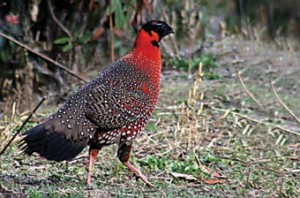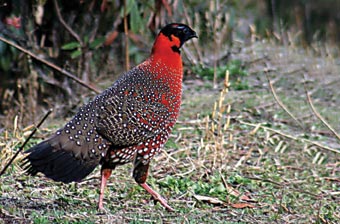Description
 This tour begins from the west and goes east, spanning the entire length of the country and passing through some of the best
This tour begins from the west and goes east, spanning the entire length of the country and passing through some of the best
birding sites in the kingdom.
The tour follows the 550 km lateral highway, linking western and eastern Bhutan, traversing through alpine and temperate vegetation of six mountain passes and numerous valleys.
The tour includes camping near birding sites, cultural visits, night halts in interior towns and short day hikes.
The main mode of travel is by road and accommodation is in hotels at designated stops and at campsites.
Details Itinerary
Day 1:~ Arrive Paro
On arrival Bhutan Bokar will receive you at the airport and escort you to your hotel.
In the afternoon, birding along the Pachhu river, you will sight waterbirds like; Ibisbill, Brown Dipper, White-capped Water Redstart, River Lapwing, Plumbeous Water Redstart, etc.
Overnight stay in hotel, Paro.
Day 2:~ Birding in Paro
Early in the morning drive to Chelela pass for pheasants: Kalij Pheasant, Satyr Tragopan, Blood Pheasant and Himalayan Monal. There is also chance of sighting the Fire-tailed Myzornis as well.
Overnight stay in hotel, Paro.
Day 3:~ Paro – Punakha
Today drive to with stop over Dochu La (pass) at 3,050 meters. The snow-capped eastern Himalayan range can be seen on a clear day. You can circumambulate the 108 stupas of the Druk Wangyal Chorten.
You will continue drive to down to the valley. The birds found in valleys of Punakha and Wangduephodrang are Himalayan Cutia, Yellow-billed Blue Magpie, Collared Grosbeak, Red Crossbill, Golden-breasted Fulvetta, White-browed Fulvetta, Fire-tailed Myzornis, Plain Mountain Finch, Mrs Gould’s Sunbird, Green-tailed Sunbird, Black-throated Parrotbill, Himalayan Bluetail, White-browed Bush Robin, Rufous-breasted Bush Robin, Rufous-gorgeted Flycatcher, Ultramarine Flycatcher, Brown Bullfinch, Red-headed Bullfinch, Chestnut-tailed Minla (Bar-throated Siva) , Dark-breasted Rosefinch, Little Bunting, White-bellied Heron, Common Kingfisher, White-throated Kingfisher, Crested Kingfisher, Grey Treepie, Spotted Nutcracker, Speckled Wood Pigeon, Slaty-backed Forktail, Spotted Forktail, Eurasian Jay, Ultramarine Flycatcher, Rusty-cheeked Scimitar Babbler,etc.
Overnight stay in hotel, Punakha.
Day 4 & 5:~ Birding in Punakha – Gasa
You will drive along the Pochu river. In this stretch you will sight Jungle Owlet, Asian-barred Owlet, Osprey, White-bellied Heron, Pallas’s Fish Eagle, Lesser Fish Eagle, Great Cormorant, Black-throated Sunbird, Green-tailed Sunbird, Black-throated Yuhina, Striped-throated Yuhina, Whiskered Yuhina, Straited Yuhina, Scarlet Minivet, Long-tailed Minivet, Grey-chinned Minivet, Barred Cuckoo Dove, Fire-breasted Flowerpecker, Darjeeling Woodpecker, Bay Woodpecker, Chestnut-headed Tesia, Slaty-bellied Tesia, Grey-bellied Tesia, White-gorgeted Flycatcher, Large Niltava, Small Niltava, Rufous-bellied Niltava, Great Barbet, Blue-throated Barbet, Golden-throated Barbet, Asian Koel, Grey-hooded Warbler, Golden-spectacled Warbler, Tickell’s Leaf Warbler, Lemon-rumped Warbler, Buff-barred Warbler, Slaty-backed Forktail, Spotted Forktail, Black-backed Forktail, Yellow-bellied Fantail, White-throated Fantail, Rusty-fronted Barwing, Hoary-throated Barwing, Blue-fronted Robin, Lesser Shortwing, Himalayan Cutia, Green Shrike-babbler, Rufous-winged Fulvetta, Yellow-throated Fulvetta, Black-eared Shrike-babbler, Spotted Wren Babbler, Pygmy Wren Babbler, Speckled Piculet, Orange-bellied Leafbird, White-tailed Nuthatch, Maroon Oriole, Scarlet Finch, Wedge-tailed Green Pigeon.
Overnight in tented camp.
Day 6:~ Punakha- Phobjikha 70km/2.5 hrs, 3000m
From Punakha you will drive eastward toward Phobjikha through the black mountain region. Phobjikha valley is one of the most important wildlife preserves in the country and it serves as the nesting grounds for the endangered Black-necked Crane in winter. The bird species found in this valley are Yellow-rumped Honeyguide, Blue-capped Rock Thrush,Fire-tailed Myzornis, Great Parrotbill, Alpine Accentor, Green-tailed Sunbird, Fire-tailed Sunbird, Rufous-vented Yuhina, Whiskered Yuhina, Scaly Thrush, Tickell’s Thrush, Fire-capped Tit, Amur falcon, Ward’s Trogon, Blue Rock Thrush, Black-faced Laughingthrush, Spotted Laughingthrush, Fire-breasted Flowerpecker, Red-headed Bullfinch, Scarlet Finch, White-tailed Nuthatch, etc.
Overnight stay in hotel, Gangtey.
Day 7:~ Phobjikha – Trongsa 87kms/ 3 hours, 2000m
Drive for three hours through dense evergreen forests of oak, rhododendron, horse chestnut, laurel, maple, fir, spruce, larch, hemlock and juniper to the central district of Trongsa crossing Pele La (pass) at 3390m. The species found in this area includes Spotted Laughingthrush, Crested Serpent Eagle, Mountain Hawk Eagle, Common Kestrel, Himalayan Griffon, Himalayan Swiftlet, Asian House Martin, Nepal House Martin, Common Rosefinch, Beatiful Rosefinch, White-browed Rosefinch, Slender-billed Scimitar Babbler, Streaked-breasted Scimitar Babbler, Brown Parrotbill, Scaly-breasted Wren Babbler, and Speckled Wood Pigeon.
Overnight stay in hotel, Trongsa.
Day 8:~ Trongsa – Zhemgang – Tingtibi 130km/4.5hrs, 1900m
Today drive to Zhemgang and Tingtibi following the Mangde Chhu River. Species found in this area are Pin-tailed Green Pigeons, Red-Headed Trogon, , Blue-bearded Bee-eater, Chestnut-breasted Partridge, Hill Partridge, Coral-billed Scimitar Babbler, Rufous-necked Hornbill, Great Hornbill, White-browed Piculet, Speckled Piculet, Bay woodpecker, White-tailed Robin, White-browed Scimitar Babbler, Black-faced Laughingthrush, Grey-headed Parrotbill, White-throated Needletail, Mountain Scops Owl, Collard Scops Owl, Collared Treepie, Pygmy-blue Flycatcher. There is a chance of spotting the highly endangered White-bellied Heron as well as the Collared Treepie, Beautiful Nuthatch and Lesser Rufous-headed Parrotbill, Greater Rufous-headed Parrotbill, Lesser-necklaced Laughingthrush, Greater Necklaced Laughingthrush.
Overnight in tented camp.
Day 9&10:~ Exploring Tingtibi
Explore Tingtibi where you can spot the Great Hornbill, Rufous-necked Hornbill, Wreated Hornbill, Lesser Yellownape, Scarlet minivet, Sultan Tit, Black-eared Shrike-babbler, White-bellied Erpornis, Long-tailed Sibia,Silver-eared Mesia, Red-billed Leiothrix, Bar-throated Siva, Blue-Winged Siva, Red-tailed Minla,Red-faced Liocichla, Rufous-necked Laughingthrush, Rufous-chinned Laughingthrush, Straited Laughingthrush, White-crested Laughingthrush, Jungle Babbler, Golden Babbler, Grey-throated Babbler, Pin-striped Tit Babbler, Long-billed Wren Babbler, Eye-browed Wren Babbler, Scaly-breasted Wren Babbler, Pygmy Wren Babbler, Puff-throated Babbler, Abbott’s Babbler, Chestnut-crowned Warbler, Grey-cheeked Warbler,Whistler’s Warbler, Rufous-faced Warbler, Black-faced Warbler, Mountain Tailorbird, Common Tailorbird, Rufescent Prinia, Straited Prinia, Mountain Bulbul, Red-whiskered Bulbul, Black-crested Bulbul, Common Green Magpie, Black-hooded Oriole, Maroon Oriole, Slender-billed Oriole, Greater Racket-tailed Drongo, Lesser Racket-tailed Drongo, Spangled Drongo, Common Iora, Black-winged Cuckooshrike, Large Cuckooshrike, Bar-winged Flycatcher-shrike, Large Woodshrike, Long-tailed Broadbill, Silver-eared Broadbill,Collared Falconet, Himalayan Goldenback, Greater Goldenback, Grey-capped Pygmy Woodpecker, Rufous-bellied Woodpecker, Rufous Woodpecker, Grey-headed Woodpecker, Eurasian Wryneck, Blue-bearded Bee-eater, Chestnut-headed Bee-eater, Green Bee-eater, Dollarbird, Chestnut-winged Cuckoo, Emerald Dove, Ashy Woodswallow, Lesser Coucal, Greater Coucal, Green-billed Malkoha,Green Imperial Pigeon, White-rumped Shama, Siberean Rubythroat, Velvet-fronted Nuthatch, White-hooded Babbler, and many species of other Woodpeckers, Blyth’s Kingfisher, and chances of sighting Hodgson’s Frogmouth, and Pied Falconet, etc.
Overnight in tented camp.
Day 11:~ Tingtibi-Bumthang
In the morning, try to spot the Beautiful Nuthatch and the Sapphire Flycatcher. After breakfast you will drive to Trongsa with visit Dzong which was built in 1648; it was seat of power over central and eastern Bhutan and visit Ta Dzong which houses royal heritage museum.
You will continue drive to Bumthang crossing Yotong la pass at 3400m en route you will spot species like Bar-throated Siva, Brown Parrotbill, Hill Partridge, Black-faced Laughingthrush, Chestnut-crowned Laughingthrush, Gold-naped Finch etc. Evening walk along the Chamkhar river to spot few species like little bunting, Red-billed Chough, Blyth’s Pipit, and Common Sandpiper.
Overnight stay in hotel, Bumthang.
Day 12:~ Exploring Bumthang
Another day for sighting pheasants if missed in the previous days. Visit Tharparling monastery for magnificent Himalayan Monal and Satyr Tragopan. Besides, you will sight Spot-winged Grosbeak, Daurian Redstart, Olive-backed Pipit, Oriental Skylark, Black-billed Magpie, etc.
Overnight stay in hotel, Bumthang.
Day 13:~ Bumthang – Sengor 5hrs
Morning drive to Sengor passing over Thrumsingla pass at 3800m.The species you would encounter are Blood Pheasant, Satyr Tragopan, Spotted Nutcracker, Fire-tailed Myzornis, Fire-tailed Sunbird, Red-headed Bullfinch, Grey Wagtail, Fire-breasted Flowerpecker, Blue-bearded Bee-eater, Fire-tailed Myzornis, Great Parrotbill, Yellow-rumped Honeyguide, Orange-flanked Bush Robin, Stripe-throated Yuhina, White-browed Fulvatas, Satyr Tragonpan, Blood Pheasnat, Himalayan Monal, White-throated Fantail ,Rufous-throated Partridge.
Overnight in tented camp.
Day 14:~ Sengor-Namling-Yongkola 4 hours
Today you travel to Namling and to Yongkola in search of species like Gould’s Shortwing, Bar-winged Wren Babblers, Yellow-rumped Honeyguide, Black-headed Shrike Babbler, White-browed Shrike Babbler, Ward’s Trogon, Slender-billed Scimitar Babbler, Blue-throated Barbet, Golden-throated Barbet, Great Barbet, Golden Bush Robin, Chestnut-breasted Partridge.
Overnight in tented camp.
Day 15&16:~ Explore Yongkola
In this area you will sight Rufous-necked Hornbil, Tawny Fish Owl, Ward’s Trogon, Red-headed Trogon, Rufous-throated Wren Babbler, Scaly-breasted Wren Babbler, Pygmy Wren Babbler, Himalayan Cutia, Grey-winged Blackbird, Hoary-throated Barwing, Rusty-fronted Barwing, Steak-breasted Scimitar Babblers, Collar-billed Scimitar Babbler, Coral-billed Scimitar Babbler, Long-tailed Minivet, Short-billed Minivet, Grey-chinned Minivet, Scarlet Minivet, Pallas’s Fish Eagle, Rufous-bellied Eagle, Black-throated Prinia, Striated Prinia, Gray-throated Babbler, Ashy Bulbull, Mountain Bulbull, Himalayan Bulbull, Grey-throated Babbler, Bhutan Laughingthrush, Chestnut-bellied Nuthatch, Beautiful Nuthatch, White-tailed Nuthatch, Asian-barred Owlet, Short-billed Minivet, Rufous-necked Laughingthrush etc.
Overnight in tented camp.
Day 17:~Yongkala – Trashigang
After breakfast drive to Samdrup jongkhar. In Samdrup Jongkhar area you would spot Silver-eared Mesia, White-rumped Shama and Greater Flameback.
Overnight stay in hotel, Trashigang.
Day 18:~ Trashigang – Samdrupjongkhar
After breakfast begin journey to the border town of Samdrup Jongkhar.
On the drive you can spot birds such as Pies falconet, Dark-rumped swift, Pin-tailed Green Gigeon, Sultan Tit, Black-backed Forktail, Red-headed Trogon, Black Eagle, House Sparrow, Jungle Babbler, Grey-sided Laughingthrush, etc.
As you descend to the foothills temperate vegetation gives way to broadleafed forests which is the habitat of the Rufous-necked Hornbill, Beautiful Nuthatch, and Gold-naped Finch.
Further down you should be able to spot the Wreathed Hornbill, the rare Violet Cuckoo, Pied Falconet, and the Greater Rufous-breasted Parrotbill.
The subtropical forests of the foothills of Samdrup Jongkhar are home to the Silver-eared Mesia, White-rumped Shama and Greater Flameback.
Overnight stay in hotel, Samdrup Jongkhar.
Day 19:- Departure
Bokar Tours will assist you with exist Bhutan immigration formalities for your onward journey to Guahati.


Reviews
There are no reviews yet.